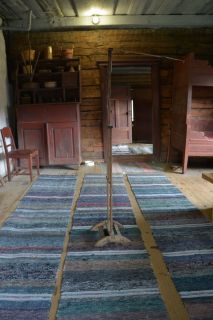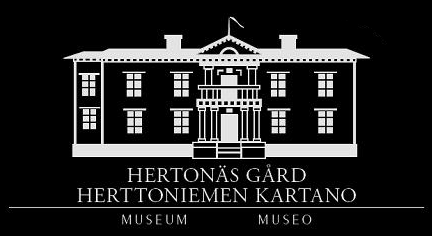Towards the end of summer 2024, cataloguing work began at Knusbacka, Hertonäs Manor. What was to be catalogued were the objects that are both stored and on exhibition in the dwelling house at Knusbacka farmstead. These objects were to be reviewed, recorded, photographed and measured in order to later be digitized. The work was done in the following way: An object was produced and photographed, then the object was searched for in the old object catalogue based on the object's signature, a description of the object was written down in the protocol, i.e. information about what kind of object the object was, the size of the object and if it was damaged, and finally the objects were placed back in the same place as they had previously been.
During the cataloguing work, several interesting peasant objects were found. These peasant objects convey their own history that gives us today a picture of what the everyday life of the peasantry could have looked like before the 1900s. Through these following objects, we now want to give a picture of what the everyday life of rural residents could look like before.
Clogs

(Caption: Clogs, Cataloguing code 1787: 1-2/176, The shoes are from Forsbacka, included in the Hertonäs Manor exhibition at Knusbacka (Photo: 5.8.2024 Casper Widd))
Clogs were a common item of clothing in the everyday life of the peasants. These clogs are made from one piece of hollowed-out, ornate wood, and have a piece of leather attached to the upper to possibly make them more comfortable to wear. Clogs were an easily made, functional garment that was used in everyday life. The clogs were either made at home by the farm people themselves, or they could also be made by a shoemaker. Common types of wood used to make clogs were alder or birch.

(Caption: Clogs, Cataloguing code 1787: 1-2/176, picture of the underside of the shoes, part of the Hertonäs Manor exhibition at Knusbacka (Photo: 5.8.2024 Casper Widd))
On the underside of the shoes, a sole of leather has been attached. This was done to protect the underside of the clogs from wearing, as well as to make them less slippery. The peasantry used clogs both as work shoes and everyday shoes.
Cheese mold

(Caption: Cheese Mold, Cataloguing code 1850/470, Picture of the inside of the cheese mold, included in the Hertonäs Manor exhibition at Knusbacka (Photo: 5.8.2024 Casper Widd))
This "Cheese Mold” is a wooden box, which was used in cheese making. The cheese mold has holes in the bottom for draining the whey from when shaping the curd. At the bottom of the cheese mold there is a pattern that makes an impression on the cheese when it is shaped. This cheese mold has a width of 21 cm, a length of 20.5 cm, and a height of 11 cm.
Cheese was a common food for the common people, and it was a good way to make use of all dairy products. The cheese mold was used in the final stage of cheese production, when the curd was produced by heating and coagulating milk, then the mass was pressed into the cheese mold so that the whey drained off and the cheese got its final shape. The patterns in the bottom of the cheese mold facilitated the drainage of the whey and it gave the cheese a decorative look. The patterns in the cheese molds could vary, including different patterns, inscriptions or even designs of animals.
The cheese molds were designed in homes and were designed so that they could be easily disassembled for cleaning after use.
Adjustable Floor Candlestick holder, Swedish namne ”Lyskärring”

(Caption: adjustable Floor Candlestick holder, Catalogue code 1800/512, photographed from the side, included in the Hertonäs Manor exhibition at Knusbacka (Photo: 5.8.2024 Casper Widd))

(Caption: adjustable Floor Candlestick holder, Catalogue code 1800/512, photographed from the front, included in the Hertonäs Manor exhibition at Knusbacka (Photo: 5.8.2024 Casper Widd))
This " adjustable Floor Candlestick holder” was used in the past by the peasants to act as a light source in the farmhouses when darkness fell. The candlestick holder is made of wood, and it is made so that the height is adjustable. The candlestick holder works so that at the top of it there is a buckle where you can attach a birch stick that is later lit to radiate light in the home. A water-filled bucket was placed under the burning stick to prevent the risk of fire.
The candlestick holder is one such tool that the common people made themselves in the home, as I said, it is mostly made of wood, the only part that is made of metal is the buckle for the light source. A candlestick holder was an easy way for the common people to cheaply light up a dark home, without having to use oil lamps or wax candles.
The everyday objects of the peasantry give us an insight into how they lived. The items included in this blog post are tools to fulfill human needs that we have always had: shoes to protect our feet, tools for the production of food, and light sources for indoor lighting. The objects meet similar needs that we still have today. But what you can note from the objects is that they are all either locally produced or made in the home. Before industrialization, custom-made things were expensive and were not produced in such large quantities, so ordinary people like the peasantry needed to be able to manufacture their tools themselves. This is also why most of these items are relatively simple utensils produced in wood.
Sources:
Information from Leif Wallin, Nordiska Museet. The information has been received by e-mail, (14.8.2024).
Digitaltmuseum.se, Lyskärring. https://digitaltmuseum.se/021027043959/lyskarring, (Accessed: 15.8.2024)
Nils Nilsson, 1971, Ostformar, Kulturen 1971, https://www.kulturen.com/wp-content/uploads/2019/06/kulturens-arsbok-1971.pdf, (retrieved: 15.8.2024)
Pages: 17 – 28.
Casper Widd's local history internship at Hertonäs Manor Museum has been funded by the Swedish Cultural Foundation in Finland.
